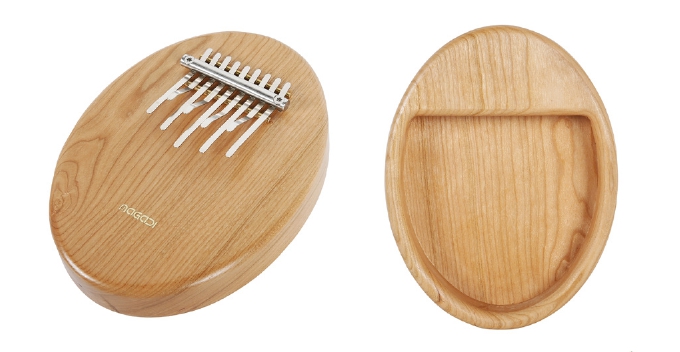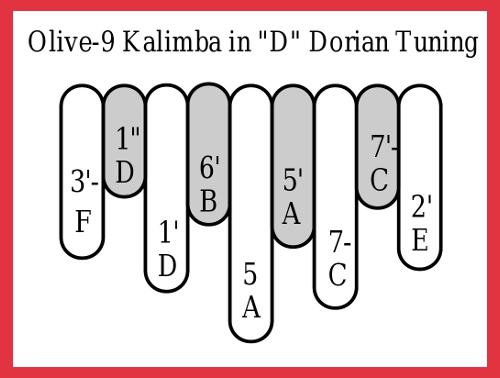
The Magadi Olive-9 Kalimba is a largely unappreciated deal. They are pretty rugged, have pretty cool special affects via the “wah wah” sound you get by tilting the kalimba body over a flat surface (like a stack of papers on a table top). And now, we are presenting a whole load of special tunings to help you fine-tune the sound you want to get out of one of these special kalimbas. And these exotic tunings are only available at Kalimba Magic.
Some instruments, such as guitar or piano, give you all the notes you might possibly need for virtually any song. A small 9-note kalimba, on the other hand, gives you the notes you need for some small fraction of music space. But it turns out you can change the songs a kalimba sings just by changing the tuning. OR: each tuning is a different universe of musical possibilities. Each one sings its own songs.
So, listen to these different tunings and figure out which sub-space of music you want to explore:
When these Magadi Kalimbas ship from China, they are in this A minor tuning. This is the tuning that is assumed in the Olive-9 Instructional Booklet. It is a fun tuning, with its own music, but you should definitely check out the other tunings too!
Thomas Bothe is a German kalimba builder who basically created new tunings with every kalimba he made. This tuning is the mirror image of the first kalimba he ever sent to me, and is typical of his style of kalimba tunings. The lower row creates one musical space – the AM9 chord – and the upper row creates a different musical space, the DM7 chord. By playing a bunch of lower row notes, followed by a bunch of upper row notes, and then returning to lower, we can create arpeggiated melodies around these two chords that are “harmonically in sync” with each other. It is beautiful and easy!
The mystic tuning is left based, and has a split in function between the upper and lower tines. The lower tines make an AM7 chord. The upper row tines, in conjunction with the 1′ = high A on the far left of the lower row, makes a five note scale segment…. but with an angelic raised 4 (signified as “4+” in the tuning diagram below). I shouldn’t assume that the sound is angelic to you, but it is angelic-sounding to me! So, the lower row tines define the AM7 harmony, and the upper tines let you play exotic melodies!
The “Desert Tunings” of the Moon-10 and Star-13 are 6-tone middle eastern scales that end up having one chord on one side, and a different chord on the other side. This is the next installment of the Desert Tuning franchise. You see the five tines on the left side are: 1 3 5 1′ 3′ – that is, the A major chord. The low A belongs to the left thumb. The right side tines, 2-, 4, 7-, are less easy to understand… but the notes G Bb D make chord G minor.
When playing in this tuning, go back and forth between these two modes of playing: (a) play a bunch of right side notes… then play a bunch of left side notes, alternating back and forth. Or (b) play scale wise, alternating left and right, weaving a melody through both sides.
Francis Bebey was an African pop musician in the 60s, 70s, and 80s. He played guitar, kalimbas, and sang. His strategy: every kalimba had its own song, and he used a different tuning for each song. This tuning is based on the tuning he used for his song “Breaths”. The notes “1 3 4 5” make the melodic contour of “Oh When the Saints… Go Marching In”. However, the flat 7th (or 7- in the tuning chart) puts an African twist on this tuning. Enchanting and wild.
This tuning is different from the others in that the central tine, C, belongs to your right thumb. How can you tell? Because the tine to the left of it is “2”, and the tine to the right is “3”. Play “1” with the right, play “2” with the left, play “3” with the right, and it works great. You can use this tuning with EZ Numbers-Based Instructional Materials.
This tuning uses a lydian scale – which is just like the major scale, but has a “raised 4” – indicated by “4+” in the tuning diagram below. The central tine belongs to the left thumb.
Dorian is a minor tuning, but has a major 6th – meaning it is dark, with some light coming through. This D dorian scale has A in the bass – the 5th. The flat 7th, or C, together with the low A, help to lead into the D or root note. Notice the 4th of the scale is missing. However, there are three octave pairs on adjacent upper/lower tines: A, C, and D. If you like minor, this is a great place to jam on.

This tuning is like the A minor Ake Bono tuning… but the 7th, or leading tone (ie, the consequential tone of the Harmonic Minor Scale) has been added for extra eerieness! The central low tine belongs to the left thumb.

Usually, I am the guy spearheading the tuning initiatives. However, most of these tunings were created by Mike Ankomues, my kalimba associate at Kalimba Magic. Just as I am retiring from the Kalimba Business, so is Mike. He has worked with Kalimba Magic since 2018, and almost every kalimba or book that you may have bought since then has been touched by his skilled hands.
On behalf of the entire kalimba community, I would like to extend a heartfelt thanks to Mike and his efforts to bring the kalimba dream to so many people! Thank you, Mike!
Of course, even though we are both retiring, I will get to play music with Mike every week with my world-beat jazz band Baba Marimba.
And I will continue on assisting the Kalimba World as Kalimba Professor Emeritus. We’ll see how that goes!


Sign up for our newsletter and free resources with your email address:
We pinky promise not to spam you and to only send good stuff.
 Christmas in July 2025
Christmas in July 2025 Patriotic and American Music for Kalimba
Patriotic and American Music for Kalimba